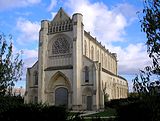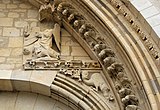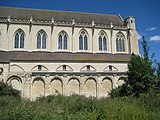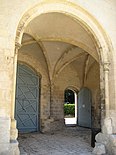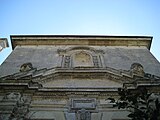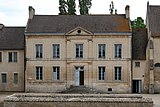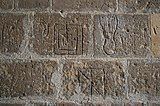User:IP108VA/sandbox
| Ardenne Abbey | |
|---|---|
 Abbey of Our Lady of Ardenne | |
| Religion | |
| Affiliation | Premonstratensian |
| Province | Calvados |
| Region | Lower Normandy |
| Rite | Roman Catholic |
| Year consecrated | 1138 |
| Location | |
| Municipality | Saint-Germain-la-Blanche-Herbe |
| Territory | France |
| Architecture | |
| Style | Gothic |
| Groundbreaking | 1121 |
| Completed | 18th century |
| Website | |
| http://www.imec-archives.com/abbaye.php | |
Our Lady of Ardenne Abbey (L’abbaye Notre-Dame d'Ardenne) was a Premonstratensian monastery founded in the 12th century in Saint-Germain-la-Blanche-Herbe, Calvados, near Caen, France. The abbey grew and flourished, with occasional declines, for centuries and by the 1620's was the most powerful Premonstratensian abbey in Normandy. During the French Revolution the monks were driven out and the abbey was sold as national property on 1 May 1791. Many of the buildings were declared a national monument in 1918, the rest in 1947. It is used today by the Institut mémoires de l'édition contemporaine (IMEC), a government-funded archive and research center.
The abbey was the site of an atrocity by the Germans during the Battle of Normandy. It was heavily damaged in the battle and has been largely rebuilt or restored.
History[edit]
The founding in the 12th century[edit]
Legend has it that in 1121, a bourgeois from Caen named Ayulphe du Marché (latinised as "Ayulfus de Foro") and his wife Asseline,[1] pious and practicing charity, had a vision of the Virgin Mary directing them to build a chapel here. They acquired seven acres of the parcel named "the Saxons' well" and established a priory of which Gilbert, a canon from Picardy became the head. In 1138, the Romanesque church which succeeded the primitive chapel was consecrated by Richard, bishop of Bayeux.[2] In 1144, the priory was attached to the Abbey of La Lucerne, placing it in the order of St. Norbert, the Premonstratensians or Norbertines. It became an independent abbey in 1160. Its abbot Robert received a gift of a stone quarry at Bretteville-sur-Odon, an important indicator of a building campaign in this period.
13th and 14th centuries[edit]
The abbey developed rapidly and its patrimony became very important:
- Priory of Saint Vincent of Lebisey (Hérouville-Saint-Clair) in 1291.
- Priory of the Hermitage (Saint-Martin-des-Besaces) at the end of the 12th century.
- Priory of St. Thomas (Lion-sur-Mer) in 1328.
- The parish priests of twelve parishes in Calvados and Orne are appointed by Ardenne.
On 23 February 1230, the choir of the abbey collapsed and killed twenty-six religious, including the third abbot, Nicolas. This disaster will have a significant impact on the plan of the abbey.
15th century[edit]
The abbey was affected by the Hundred Years' War. On 14 December 1417, during the siege of Caen, the monks took refuge in the city to escape the looting of the abbey. On 5 June 1450 during the siege of Caen, the abbey was occupied by Charles VII of France who left only after the surrender of the English garrison on 5 July. The war ended, the abbot Robert Chartier had the cloister and another conventual building rebuilt.
16th century[edit]
A regime of commendatory abbots was introduced at Ardenne and the abbey declined. During the Wars of Religion, monks twice took refuge in Caen. In 1562, abbey buildings were destroyed, vandalized or abandoned—the abbey church was used as a cowshed. For many years, the abbey remained in a state of ruin, occupied only by two or three monks. Community life gradually resumed and in 1587 there were eight canons, four novices and their master.
A reorganization was carried out by the prior Jean de la Croix, who came from the abbey of Belle-Étoile in 1596. He restored the abbey materially and spiritually, and remained spiritual leader of Ardenne for nearly fifty-eight years. He brought more rigor to the rule of the abbey from 1598, following the action of Servais de Lairuelz, vicar general of the order of Norbertines at Pont-à-Mousson.
17th century[edit]

The restoration continued thanks to a concordat concluded in 1602 between the prior and the new abbot commendataire, Pierre of Villemor. Although the latter disapproved of the rehabilitation of the abbey for financial reasons, new furniture was purchased as well as liturgical vestments and altar linens. In 1609, the church was consecrated. Also built were a dormitory, a library and a new high altar which was consecrated in 1639. It was probably Jean de la Croix who enclosed the arcades of the Gothic cloister to transform the clerestory into a gallery well protected from the wind.
On 12 November 1627, the prior, in conflict with his abbot commendataire Guillaume Galodé, capitulairement adopted, by a strong majority, the reform statutes of Pont-à-Mousson. The Abbey had acceded to the Congregation of Lorraine, after having obtained guarantees on regionalization (Lorraine was not part of the kingdom of France), particularly with regard to the novitiate and of "migrations" of religious. Jean de la Croix then convinced other abbeys to accede to this reform, in spite of strong opposition such as that of the general chapter of Premonstratensians. Ardenne became the most powerful Premonstratensian abbey of Normandy and the number of religious reached thirty in 1628.
Jean de la Croix died 4 January 1654, and a manuscript reported that he was "buried below the sanctuary, toward the East". After his death, the architectural renovation continued. A new monumental gate, dedicated to St. Norbert, giving immediate access from the north to regular places, was completed in 1672.[3] At this time, Ardenne reigned over numerous establishments and controlled all the surrounding mills. In 1686, the ruined arches of the abbey church were replaced by wooden croisee d'ogives; the gallery that runs the length of the cloister was restored in 1689 and two chapels were built against the north wall of the church.
18th century[edit]
This century was especially known for the methodical refurbishment of the buildings. In 1766, the east gallery of the cloister was rebuilt and the former capitulary room was demolished. The pressoir was re-established and on its north side a new abbatial logis was constructed after 1711, outside the regular places, to the benefit of the commendatory abbot who was not part of the community of canons. This building, no longer in existence, was attributed to the architect Pierre Queudeville of St. Nicholas parish in Caen.
During the French Revolution the monks were driven out and the abbey was sold as national property on 1 May 1791 to a Parisian named Chauffrey. In 1795, three successive sales dispersed the furniture and numerous tableaux: the 18th century high altar with its two statues in polychrome wood of Saint Norbert and Saint Augustine was transferred in 1812 to the Church of Saint-Jean in Caen.[4]. The abbey was acquired in 1799 by an Englishman, William Russell, who lived there until 1814. For some time, he made the abbey church a Protestant temple.
19th century[edit]
After 1814, the territory of the abbey was divided among different owners—it was occupied by three distinct agricultural enterprises. Around 1820–1823, the cloister and most of the abbatial logis were demolished, and about 1830 Arcisse de Caumont, the Norman archeologist, witnessed other damage due to the removal of stones for other construction. Farm buildings were built by the new owners.
20th century[edit]

In 1918, the patrimonial value of the abbey was officially recognized—a great part of the former abbey (the church, the north gate, the surrounding walls, the tithe barn, the west gate-lodge) was classified as an historic monument from 28 August 1918.[5] The remainder of the abbey was so classified on 21 October 1947.[5]
During the Second World War, one of the owners, Roland Vico, was active in the Resistance. The buildings hosted an arsenal and a clandestine center for rifle exercises before being evacuated when the site was occupied by German soldiers. The Germans used the towers of the abbey to observe the surrounding area all the way to the sea, which is visible from them. The abbey is on a high point on the plain, at 67 meters of altitude.[6] The abbey was at the heart of the fighting and was seriously damaged, especially the medieval barn. The abbey was retaken from the Germans by the Canadian army the night of 8 July 1944. The abbey's designation as an historic monument allowed the owners to do restoration work thanks to indemnifications for war damage. In 1947, the church facade collapsed and was reconstructed.
Restoration[edit]
Plusieurs projets sont élaborés autour de l'abbaye, dont celui de la ville de Caen, qui souhaite, en 1971, en faire un centre culturel. En 1985, Ardenne est acquise par l'EPBS (Établissement public et financier de la Basse-Seine). Finalement, la Région Basse-Normandie achète l’ensemble de l’abbaye, encore partagée entre trois propriétaires, au début des années 1990 afin d’accueillir des étudiants américains dans le cadre du programme “Normandy Scholar program”. Une nouvelle campagne de restauration reprend, sous la direction de l’architecte Bruno Decaris, architecte en chef des monuments historiques. Cependant, le site est sous-exploité en regard de son potentiel d'accueil. À partir de 1996, la restauration de l’abbaye, financée par la région avec la participation de l’État, se trouve motivée par un projet de décentralisation régionale : l'emménagement en ses murs de l'Institut mémoires de l'édition contemporaine. Les architectes choisis sont Bruno Decaris et Agnès Pontremoli. Leur travail d'adaptation des bâtiments aux futurs usages bouleverse profondément l'aspect intérieur de l'église abbatiale et de la grange aux dîmes, tout en respectant l'aspect originel des extérieurs. L'abbaye devient donc un centre de recherche important, devenant en 1998 membre du réseau européen des centres culturels de rencontre (Label CCR) qui compte quarante membres en Europe aujourd'hui.
List of abbots of Ardenne[edit]
Coat of arms of the abbey[edit]
- de gueules, à une crosse d'argent, accostée de deux fleurs de lys d'or (according to D'Hozier),[7] or,
- parties; au premier, d'un demi écusson de France; au deuxième, d'azur à la vierge d'or, debout, tenant son fils sur un bras et de l'autre un rameau (according to M. R. Bordeaux)[7]
Architecture[edit]
The abbey-church[edit]
Le premier édifice fut consacré en 1138, pendant la période romane. Ce qui subsiste est du début du XIIIe siècle, bien que la période de construction s'étale sur plusieurs périodes, jusqu'au XVIIe siècle. Le transept ne fut pas intégré aux travaux de restauration de 1230, après l'effondrement du chœur, mais réutilisé comme « chanterie », vestibule et sacristie. Quelques maladresses apparaissent dans la construction, par le manque de parallélisme entre le mur sud et les six premières travées, sans doute parce que le constructeur avait mal pris ses repères à partir du cloître. Le bâtiment est à deux étages, l'étage inférieur a des grandes arcades supportées par des piles cylindriques et le supérieur étant éclairé par des fenêtres. La voûte en bois est particulière, réalisée en bois au XVIIe siècle dans le style gothique. Une autre particularité est que les fenêtres hautes sont plus larges que les autres. De plus, les baies du côté sud sont construites de deux hauteurs différentes. D'autres irrégularités de niveau et quelques différences de décor sur les balustrades peuvent être observées, démontrant des discontinuités dans les restaurations. Les chapiteaux sont ornés de crochets et feuillages élégants, dans le style à l'honneur en Normandie au XIIIe siècle, de même que les décors à trèfles à trois et quatre feuilles du XIVe siècle. À l'extérieur, deux tourelles octogonales, jadis surmontées de flèches, encadrent une façade gothique. Elle se compose d'un portail dont le tympan a été reconstruit sans restitution des décors disparus lors de la bataille de 1944 et de l'effondrement de 1947, d'une rose surmontée par une coursière passant derrière un garde-corps ajouré et d'un pignon couronné par des rampants décorés de crochets.
La nef abrite aujourd'hui une bibliothèque d'archives, dont l'architecture contemporaine accolée aux piles de l'église peut surprendre ou séduire. C'est là que sont déposés, dans une atmosphère surveillée, les fonds documentaires de l'IMEC.
-
The IMEC library, in the former abbey church
-
The abbey church from the back
-
The restored façade of the church
-
Decorative sculptures of the church
-
Capitals and sculptures of the façade
-
Sculptures on the front portal
-
Vault of the former abbey church
-
Vestiges of the cloister
The Bayeux gate[edit]
C'est le plus vieux bâtiment de l'abbaye. Selon la règle de Saint-Norbert, on accédait aux abbayes par quatre portes, situées aux quatre points cardinaux. Si La Lucerne eut ses quatre portes, les archives ne permettent pas de dire s'il en fut ainsi à Ardenne. La porte ouest, ou porte de Bayeux, est du XIIIe siècle. Construite dans le style roman normand qu'on retrouve au prieuré proche de Bretteville-sur-Odon ou à celui de Saint-Vigor-le-Grand, cette porterie comporte un étage habitable. L'accès à la basse-cour se fait par une double porte charretière surmontée de voussures en plein cintre. Une porte piétonne à arc brisé l'accompagne. Le passage se fait sous une voûte à croisée d'ogives. Du côté de la cour, l'étage est éclairé par trois belles fenêtres à meneaux. Dans cette pièce était rendue la justice temporelle, confrontant parfois les chanoines et leurs fermiers, ou les fermiers entre eux.
-
Porte de Bayeux, côté cour
-
Porte de bayeux : la Porte piétonne
-
Voûtes de la porte
The Saint-Norbert gate[edit]
Construite dans la première moitié du (XVIIIe siècle), son style est pourtant proche de celui du XVIIe siècle et de l'influence jésuite, avec son appareil à bossages et son toit en dôme. Au-dessus du fronton trapézoïdal orné à chaque extrémité d'épis, une niche a dû abriter autrefois une statue de Saint-Norbert.
De chaque côté du pavillon, deux ailes divisées en cinq travées par des pilastres abritait à l’origine une écurie voûtée et une sellerie. L’ensemble long de quarante mètres est prolongé à l’ouest par une ancienne porcherie. Dans la cour, des pelouses entrecoupées d'allées ont été aménagées récemment.
-
Porte Saint-Norbert, côté cour (façade sud)
-
Détail depuis l'allée menant à l'abbaye (façade nord)
-
Façade nord au début du XXe siècle
The tithe barn[edit]
Du XIIe siècle, elle est une des plus belles granges monastiques de Normandie. Longue de 48 mètres et large de 16, elle rappelle l'importance des domaines agricoles de l'abbaye. De puissantes piles cylindriques séparent à l'intérieur la nef centrale des deux bas-côtés. Parfaitement restaurée en 1952 des dégâts de 1944, elle a été aménagée à la fin du XXe siècle pour accueillir un centre culturel de rencontre et des expositions ouvertes au public.
From the 12th century, the tithe barn is one of the most beautiful in Normandy. Forty-eight meters long and 16 wide, the barn recalls the importance of agriculture to the abbey.
The monastery buildings[edit]
Ce sont les éléments d'architecture ayant le plus souffert des destructions. Il ne reste que la cuisine, intégrée aux bâtiments sud, comprenant également la boulangerie, des celliers et des chambres pour les domestiques des hôtes. En 2008, cette partie de l'abbaye reste encore à restaurer.
Du mur d'enceinte, il reste un mur continu de deux kilomètres de pourtour.
The farm buildings[edit]
Bien que terminés au XVIIe siècle ou remaniés pour les adapter à la vie agricole, ils comportent une majorité d'éléments médiévaux. Le bâtiment nord a conservé ses contreforts. L'aile sud présente moins d'intérêt. Toutefois, le logement du fermier est tel qu'il apparait sur le plan du XVIIIe siècle et comporte une belle salle voutée. Le logis près de la porte de Bayeux a été édifié en 1825. Dans les bâtiments côté sud, il est prévu d'aménager un espace d'accueil du public, avec boutiques et bar.
-
Logis de la ferme
-
La ferme, côté sud
-
La basse-cour avec, au centre, les écuries
Le farinier[edit]
Du XVIIIe siècle, le farinier comprenait une boulangerie, un cellier, un corps de logis pour les domestiques et des greniers à blé. Il est aujourd'hui un lieu de résidence pour les chercheurs, comprenant quinze chambres et une salle de travail.
-
Le farinier
-
La cuisine, bâtiment non restauré accolé au farinier
Le pavillon des archives[edit]

Seul bâtiment récent de l'abbaye, il est consacré au traitement et à la conservation des archives déposées à l'IMEC, l'Institut Mémoires de l'Édition Contemporaine.
Visite[edit]
Par décret en date du 16 juillet 2003, un périmètre de 200 hectares autour de l'abbaye est classé, ensemble formé par l’abbaye d’Ardenne et les terrains avoisinants sur le territoire des communes d’Authie, de Caen et de Saint-Germain-la-Blanche-Herbe. Il permet de sauvegarder l’essentiel des « vues » sur l’abbaye, menacées par l'extension de l'agglomération, de même que les terres agricoles qui l’entourent, comme par le passé.
L'enceinte de l'abbaye se visite librement du lundi au vendredi de 14h à 18h.
L'ancienne grange accueille régulièrement des expositions (entrée payante), des tables rondes et des conférences ouvertes à tous, et occasionnellement des concerts[8].
Près du mur d'enceinte, au sud-ouest, on peut aujourd'hui se recueillir dans le « jardin canadien du souvenir », avec oratoire, en souvenir des dix-huit soldats massacrés par les SS. Tous les ans, à la date du 7 juin, une commémoration y est organisée.
-
Le jardin du souvenir, où ont été tués les soldats canadiens
-
Graffitis
-
Enceinte sud et sa porte condamnée
Ardenne Abbey massacre[edit]
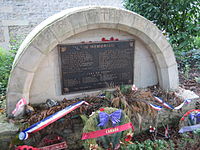
The abbey was used as an observation post by the Germans in the Battle of Normandy. In June 1944, 20 Canadian soldiers were illegally executed at the abbey by members of the 12th SS Panzer Division Hitlerjugend. During the Normandy Campaign, Brigadeführer Kurt Meyer, commander of the 25th Panzer Grenadier Regiment, used the Ardenne Abbey for his regimental headquarters, as the towers allowed for a clear view of the battlefield.[9] There is a memorial to the murdered soldiers in the abbey garden, unveiled on 6 June 1984. Under the title "IN MEMORIAM", the inscription, in English and French, reads: ON THE NIGHT OF 7-8 JUNE 1944, EIGHTEEN CANADIAN SOLDIERS WERE MURDERED IN THIS GARDEN WHILE BEING HELD HERE AS PRISONERS OF WAR. TWO MORE PRISONERS DIED HERE, OR NEARBY, ON 17 JUNE 1944. THEY ARE GONE BUT NOT FORGOTTEN. LEST WE FORGET. This is followed by the names and ranks of those killed.[10]
See also[edit]
External links[edit]
- Saint-Germain la Blanche Herbe commune website
- IMEC website
References[edit]
- ^ In his article on the Abbey d'Ardaine, Guillaume-Stanislas Trébutien makes reference to Aïulphe du Marché and to his wife Asceline (Guillaume-Stanislas Trébutien, Caen: précis de son histoire, ses monuments, son commerce et ses environs, Caen, A. Hardel, 3e éd., 1872). Élie Lambert translates Ayulfus de Foro as Ayoul de Laplace (Élie Lambert, "L'abbaye d'Ardenne (Calvados)" dans le Bulletin de la Société des antiquaires de Normandie, t. 45, p. 198 "read online".).
- ^ Archives départementales du Calvados, série H, fonds d'Ardenne
- ^ Gabriel Vanel, "Remarques de Nicolas le Hot, avocat au bailliage de Caen en 1680, publiées d’après le manuscrit inédit" dans le Bulletin de la Société des antiquaires de Normandie, Caen, 1906, tome 25, p. 40
- ^ Ministère de la Culture (base Pallisy - Référence PM14000187)
- ^ a b Base Mérimée: PA00111675, Ministère français de la Culture. (in French)
- ^ T. Leprévost, L'Affaire Brière, Heimdal, 1990.
- ^ a b Canel, Alfred (1849). Armorial de la province des villes de Normandie. Rouen: A. Péron. Retrieved 10 July 2013..
- ^ "Site de l'Imec - Activités". Retrieved 12 June 2013.
- ^ Margolian, 44.
- ^ Veterans Affairs Canada, “Abbaye d’Ardenne.”
Bibliography[edit]
- de Caumont, Arcisse (1846). Statistique monumentale du Calvados. Vol. 1. Caen: Hardel. pp. 71–88.
{{cite book}}: Cite has empty unknown parameter:|titre volume=(help)}}. - E. de Beaurepaire, "les découvertes de l'Abbaye d'Ardenne", Bull. de la Société des antiquaires de Normandie, vol. VIII, 1876.
- E. Liot, Excursion à l'abbaye d'Ardenne, Adeline, 1890.
- L. Musset, "L'Abbaye d'Ardenne", revue Art de Basse-Normandie, numéro 2, 1956.
- Yves Chevrefils Desbiolles, L'Abbaye d'Ardenne. Histoires du XIIe au XIXe, IMEC éditeur, 2007.
- Margolian, Howard. Conduct Unbecoming: The Story of the Murder of Canadian Prisoners of War in Normandy. Toronto: University of Toronto Press, 1998.
- Veterans Affairs Canada. "Abbaye d’Ardenne" Accessed 8 July 2013.
49°11′47″N 0°24′50″W / 49.1964917°N 0.4138917°W
| This page contains a translation of L'abbaye d'Ardenne from fr.wikipedia. |
Category:Buildings and structures in Calvados Category:Premonstratensian monasteries in France Category:1121 establishments in France Category:Religious organizations established in the 1120s Category:Christian monasteries established in the 12th century Category:Visitor attractions in Lower Normandy Category:Visitor attractions in Calvados




